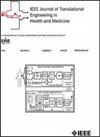A Practical Sensor-to-Segment Calibration Method for Upper Limb Inertial Motion Capture in a Clinical Setting
IF 4.4
3区 医学
Q2 ENGINEERING, BIOMEDICAL
IEEE Journal of Translational Engineering in Health and Medicine-Jtehm
Pub Date : 2025-04-30
DOI:10.1109/JTEHM.2025.3565986
引用次数: 0
Abstract
Inertial sensors have the potential to be a useful clinical tool because they can facilitate human motion capture outside the research setting. A major barrier to the widespread application of inertial motion capture is the lack of accepted calibration methods for ensuring accuracy, in particular the lack of a common convention for calculating the rotational offset of the sensors, known as sensor-to-segment calibration. The purpose of this study was to develop and test a sensor-to-segment calibration method for upper limb motion capture which is practical for clinical applications.We developed a calibration method which depends mainly on the estimation of joint axes from arbitrary elbow motion, and partially on the design of custom attachment mounts to achieve physical alignment. With twenty healthy participants, we used OpenSim’s inertial sensor workflow to calculate joint kinematics, and evaluated the accuracy of the method through comparison with optical motion capture.We found the new calibration method resulted in upper limb kinematics with a median RMS error of 5–8°, and a median correlation coefficient of 0.977–0.987, which was significantly more accurate than a static pose calibration (p-value < 0.001).This work has demonstrated a method of calibration which is practical for clinical applications because it is quick to perform and does not depend on the subject’s ability to perform specific movements, or on the operator’s ability to carefully place sensors.Clinical Impact: The calibration method proposed in this work is a realistic option for the translation of inertial sensor technology into everyday clinical use.一种实用的上肢惯性运动捕捉传感器-节段校准方法
惯性传感器有潜力成为一种有用的临床工具,因为它们可以促进研究环境之外的人体运动捕捉。惯性运动捕捉广泛应用的一个主要障碍是缺乏公认的校准方法来确保精度,特别是缺乏计算传感器旋转偏移量的通用约定,称为传感器到段校准。本研究的目的是开发和测试一种用于上肢运动捕捉的传感器到节段校准方法,该方法可用于临床应用。我们开发了一种校准方法,该方法主要依赖于从任意肘关节运动中估计关节轴,部分依赖于定制附件安装的设计来实现物理校准。在20名健康参与者中,我们使用OpenSim的惯性传感器工作流程来计算关节运动学,并通过与光学运动捕捉的比较来评估该方法的准确性。结果表明,该方法的上肢运动学标定的中位数均方根误差为5 ~ 8°,中位数相关系数为0.977 ~ 0.987,显著优于静态位姿标定(p值< 0.001)。这项工作证明了一种适用于临床应用的校准方法,因为它可以快速执行,并且不依赖于受试者执行特定动作的能力,也不依赖于操作员仔细放置传感器的能力。临床影响:这项工作中提出的校准方法是将惯性传感器技术转化为日常临床使用的现实选择。
本文章由计算机程序翻译,如有差异,请以英文原文为准。
求助全文
约1分钟内获得全文
求助全文
来源期刊

IEEE Journal of Translational Engineering in Health and Medicine-Jtehm
Engineering-Biomedical Engineering
CiteScore
7.40
自引率
2.90%
发文量
65
审稿时长
27 weeks
期刊介绍:
The IEEE Journal of Translational Engineering in Health and Medicine is an open access product that bridges the engineering and clinical worlds, focusing on detailed descriptions of advanced technical solutions to a clinical need along with clinical results and healthcare relevance. The journal provides a platform for state-of-the-art technology directions in the interdisciplinary field of biomedical engineering, embracing engineering, life sciences and medicine. A unique aspect of the journal is its ability to foster a collaboration between physicians and engineers for presenting broad and compelling real world technological and engineering solutions that can be implemented in the interest of improving quality of patient care and treatment outcomes, thereby reducing costs and improving efficiency. The journal provides an active forum for clinical research and relevant state-of the-art technology for members of all the IEEE societies that have an interest in biomedical engineering as well as reaching out directly to physicians and the medical community through the American Medical Association (AMA) and other clinical societies. The scope of the journal includes, but is not limited, to topics on: Medical devices, healthcare delivery systems, global healthcare initiatives, and ICT based services; Technological relevance to healthcare cost reduction; Technology affecting healthcare management, decision-making, and policy; Advanced technical work that is applied to solving specific clinical needs.
 求助内容:
求助内容: 应助结果提醒方式:
应助结果提醒方式:


